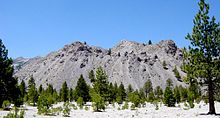
Back Lawakoepel Afrikaans قبة حمم بركانية Arabic Domo de llava AST Vulkanik günbəzlər Azerbaijani Лавов купол Bulgarian Dom de lava Catalan Sopečný dóm Czech Lavakuppel Danish Lavadom German Ηφαιστειακός δόμος Greek



In volcanology, a lava dome is a circular, mound-shaped protrusion resulting from the slow extrusion of viscous lava from a volcano. Dome-building eruptions are common, particularly in convergent plate boundary settings.[1] Around 6% of eruptions on Earth form lava domes.[1] The geochemistry of lava domes can vary from basalt (e.g. Semeru, 1946) to rhyolite (e.g. Chaiten, 2010) although the majority are of intermediate composition (such as Santiaguito, dacite-andesite, present day)[2] The characteristic dome shape is attributed to high viscosity that prevents the lava from flowing very far. This high viscosity can be obtained in two ways: by high levels of silica in the magma, or by degassing of fluid magma. Since viscous basaltic and andesitic domes weather fast and easily break apart by further input of fluid lava, most of the preserved domes have high silica content and consist of rhyolite or dacite.
Existence of lava domes has been suggested for some domed structures on the Moon, Venus, and Mars,[1] e.g. the Martian surface in the western part of Arcadia Planitia and within Terra Sirenum.[3][4]
- ^ a b c Calder, Eliza S.; Lavallée, Yan; Kendrick, Jackie E.; Bernstein, Marc (2015). The Encyclopedia of Volcanoes. Elsevier. pp. 343–362. doi:10.1016/b978-0-12-385938-9.00018-3. ISBN 9780123859389.
- ^ Fink, Jonathan H.; Anderson, Steven W. (2001). "Lava Domes and Coulees". In Sigursson, Haraldur (ed.). Encyclopedia of Volcanoes. Academic Press. pp. 307–19.
- ^ Rampey, Michael L.; Milam, Keith A.; McSween, Harry Y.; Moersch, Jeffrey E.; Christensen, Philip R. (28 June 2007). "Identity and emplacement of domical structures in the western Arcadia Planitia, Mars". Journal of Geophysical Research. 112 (E6): E06011. Bibcode:2007JGRE..112.6011R. doi:10.1029/2006JE002750.
- ^ Brož, Petr; Hauber, Ernst; Platz, Thomas; Balme, Matt (April 2015). "Evidence for Amazonian highly viscous lavas in the southern highlands on Mars". Earth and Planetary Science Letters. 415: 200–212. Bibcode:2015E&PSL.415..200B. doi:10.1016/j.epsl.2015.01.033.
© MMXXIII Rich X Search. We shall prevail. All rights reserved. Rich X Search